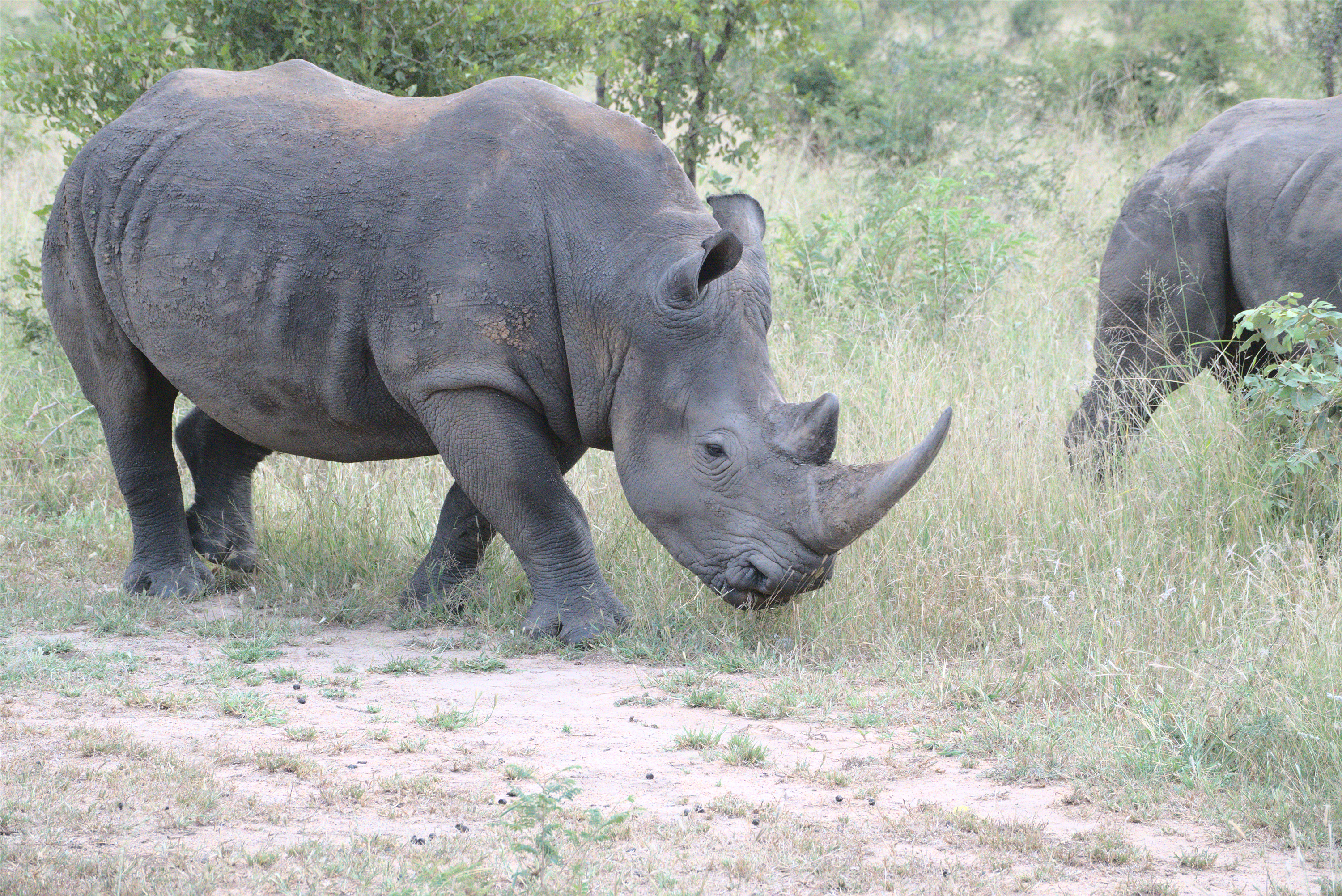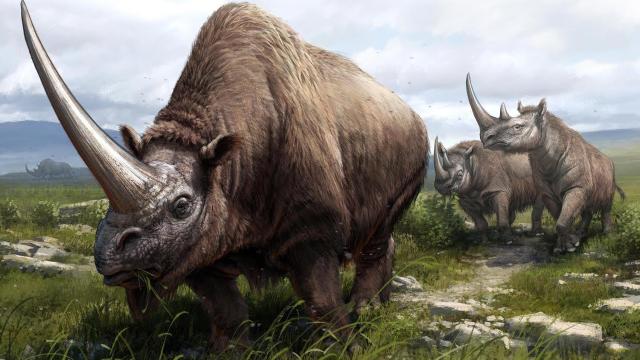New research details the evolutionary history of rhinoceroses, exposing a surprising lack of genetic diversity throughout their long history. Given that all living species of rhinos are currently endangered and facing their own genetic bottlenecks, the new research could improve conservation efforts.
At a scientific meeting held a few years ago in Copenhagen, paleogeneticist Love Dalén from the Swedish Museum of Natural History met with Tom Gilbert, an evolutionary biologist from the University of Copenhagen. They discussed a possible scientific collaboration, wherein the topic of rhinos came up, as each was independently studying these horned mammals. This set the ball in motion, leading to a project in which Dalén and Gilbert, along with experts from around the world, used both ancient and modern genomes to study the evolutionary history of the rhinoceros family.
A collaboration made sense, given that scientists have struggled to reconstruct the rhino family tree. Biologist Charles Darwin even took a stab at it, writing an essay on the subject 17 years before his seminal work, On the Origin of Species, published in 1859.
Studying rhino history has been a challenge because all rhinos currently in existence are highly endangered and the focus of conservation efforts. What’s more, the vast majority of rhinos went extinct prior to the Pleistocene epoch, which began some 2.58 million years ago. The rhino family emerged between 55 million and 60 million years ago, having diverged from tapirs. Rhinos would go on to experience tremendous success, spawning more than 100 different species and spreading across Africa, Eurasia, and North and Central America.
Some rhinos got really big, like the woolly rhinoceros (Coelodonta antiquitatis). Weighing upwards of 2,000 kg, these rhinos had a shaggy coat, a gigantic hump, and a formidable 1.5-metre horn. By the time the Pleistocene ended around 11,500 years ago, however, only nine rhino species remained on Earth.
To better understand rhinos in terms of their history and distant ancestors, the team charted the genetic relationships of five living rhino species to three species of rhino that went extinct just prior to the end of the last ice age: the Siberian unicorn (Elasmotherium sibiricum), Merck’s rhinoceros (Stephanorhinus kirchbergensis), and the aforementioned woolly rhino. Black rhinos (Diceros bicornis), white rhinos (Ceratotherium simum), Sumatran rhinos (Dicerorhinus sumatrensis), greater one-horned rhinos (Rhinoceros unicornis), and Javan rhinos (R. sondaicus), were the living species included in the study.

The ensuing analysis showed that an ancestral split happened 16 million years ago during the early Miocene, creating two distinct rhino lineages, one in Africa and one in Eurasia. This split was due to their geographical spread and not the result of an emerging physical difference, namely the appearance of one-horned and two-horned rhinos.
The other key finding is that rhinos have a long history of low genetic diversity. A lack of genetic diversity is a sign of small populations, and it can lead to all sorts of genetic diseases as the result of deleterious mutations. This happened to woolly mammoths in their final days.
“All eight species generally displayed either a continual but slow decrease in population size over the last 2 million years, or continuously small population sizes over extended time periods,” Mick Westbury, a co-author of the study and a researcher at the University of Copenhagen, explained in an emailed press release.
As this research suggests, ancient rhinos somehow managed to cope with or adapt to continuously small populations. Scientists have a cool term to describe the process that makes this possible: the purging of mutational load.
“Species aren’t adapted to low diversity, but in some ways one could say that they can adapt to being at small population size,” wrote Dalén in an email. “What theory predicts is that natural selection can remove deleterious mutations from the population, even when the population size becomes small. This is not an adaptation to low diversity, but should rather in my view be seen as an adaptation to inbreeding.”
So low genetic diversity, despite being an indelible part of rhino history, did not led to health declines as the result of inbreeding and harmful mutations. Interestingly, rhinos aren’t alone in this regard. The cat family (Felidae) has even lower genetic diversity, as Dalén explained. He said this is not too surprising, “since carnivores typically have lower diversity than herbivores, since their population sizes generally are smaller.”
But while “low genetic diversity is a long-term feature” of the rhino family, it has “been particularly exacerbated recently,” likely because humans have pushed these creatures toward extinction, as the biologists write in their study, published today in Cell.
Indeed, while the historic purging of mutational load may have prevented genetic problems from creeping in, the exceedingly low population sizes of modern rhinos are a different story. As the paper points out, the average genetic diversity observed in four modern-day rhino genomes were measured at about half of what was seen in the ancient genomes (the Javan rhino was included as a historical species because its DNA came from an individual who lived 200 years ago — prior to human influences on rhino populations).
Rhinos, as the study suggests, successfully purged unhealthy mutations over the past 100 years, but present-day rhinos are now having to contend with lower levels of genetic variation and higher rates of inbreeding compared to their ancestors. This is the result of overhunting and habitat destruction, and it’s placing these species at risk of extinction.
Thankfully, the new paper can inform current conservation efforts. Low genetic diversity, as the research suggests, is not necessarily indicative of rhinos being in trouble. Rather, conservationists should focus on increasing their population size, as opposed to boosting their individual genetic diversity. In practice, “this means that the main conservation focus should be on avoiding illegal poaching and destruction of the rhinos’ favoured habitat,” Dalén said, and the approach should vary depending on the species. African rhinos, for example, are threatened by illegal poaching, whereas Sumatran rhinos are threatened by the destruction of their preferred habitat, he explained.
“Having said that, I don’t think we can ignore the threat from low genetic diversity and inbreeding either,” Dalén added. “All rhinos still have harmful mutations in their genomes, even if perhaps less so than in ancient times. And given the small population sizes most rhinos have at the moment, it is very likely that inbreeding will keep increasing in the future. If that happens, we will see an increase in genetic diseases.”
Dalén’s advice to conservation managers is to do what they can to prevent poaching and protect the rhinos’ remaining habitat, “if there is to be a chance that future generations will get to see these animals.”
